weight PORSCHE CAYNNE 2010 1.G Information Manual
[x] Cancel search | Manufacturer: PORSCHE, Model Year: 2010, Model line: CAYENNE, Model: PORSCHE CAYENNE 2010 1.GPages: 68, PDF Size: 4.52 MB
Page 6 of 68
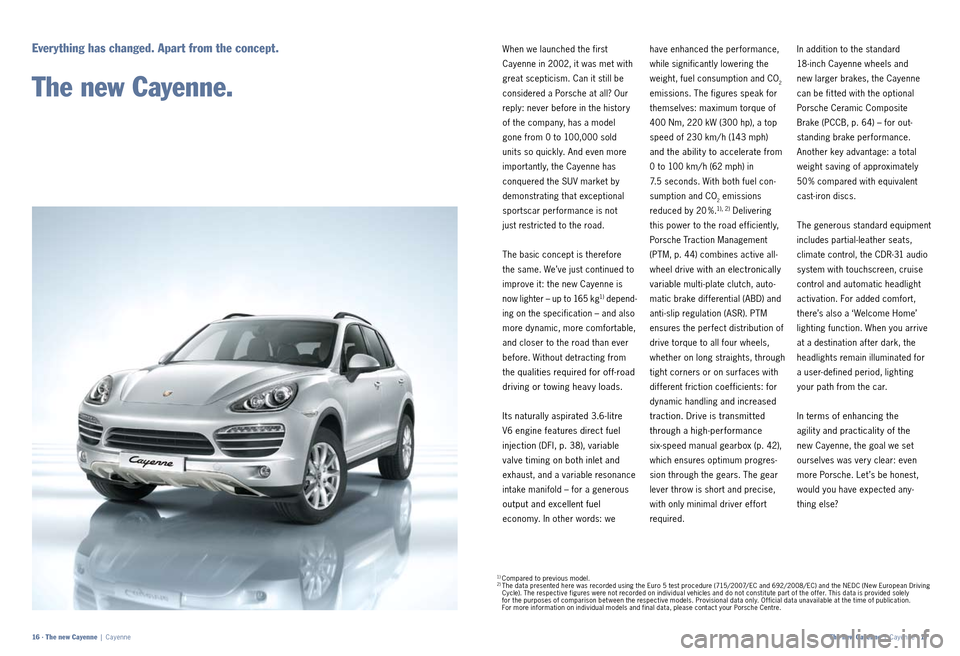
When we launched the first
Cayenne in 2002, it was met with
great scepticism. Can it still be
considered a Porsche at all? Our
reply: never before in the history
of the company, has a model
gone from 0 to 100,000 sold
units so quickly. And even more
importantly, the Cayenne has
conquered the SUV market by
demonstrating that exceptional
sportscar performance is not
just restricted to the road.
The basic concept is therefore
the same. We’ve just continued to
improve it: the new Cayenne is
now lighter – up to 165 kg1) depend
ing
on the specification – and also
more dynamic, more comfortable,
and closer to the road than ever
before. Without detracting from
the
qualities required for off road
driving or towing heav y loads.
Its naturally aspirated 3.6 litre
V6 engine features direct fuel
injection (DFI, p. 38), variable
valve timing on both inlet and
exhaust, and a variable resonance
intake manifold – for a generous
output and excellent fuel
economy. In other words: we have enhanced the performance,
while significantly lowering the
weight, fuel consumption and CO
2
emissions. The figures speak for
themselves: maximum torque of
400 Nm, 220 kW (300 hp), a top
speed of 230 km/ h (143 mph)
and the abilit y to accelerate from
0 to 100 km/ h (62 mph) in
7.5 se conds. With both fuel con
sumption and CO
2 emissions
reduced by 20 %.
1), 2) Delivering
this power to the road efficiently,
Porsche Traction Management
(PTM, p. 44) combines active all
wheel drive
with an electron ically
variable
multi plate clutch, auto
matic brake dif ferential (ABD) and
anti slip regulation (ASR). PTM
ensures the perfect distribution of
drive torque to all four wheels,
whether on long straights, through
tight corners or on surfaces with
dif ferent friction coef ficients: for
dynamic handling
and increased
traction. Drive is transmit ted
through a high performance
six speed manual gearbox (p. 42),
which ensures optimum progres
sion through the gears. The gear
lever throw is short and precise,
with only minimal driver ef fort
required. In addition to the standard
18
inch Cayenne wheels and
new larger brakes, the Cayenne
can be fit ted with the optional
Porsche Ceramic Composite
Brake (PCCB, p. 64) – for out
standing brake performance.
Another key advantage: a total
weight saving of approximately
50 % compared with equivalent
cast iron discs.
The generous standard equipment
includes partial leather seats,
climate control, the CDR 31 audio
system with touchscreen, cruise
control and automatic headlight
activation. For added comfort,
there’s also a ‘Welcome Home’
lighting function. When you arrive
at a destination af ter dark, the
headlights remain illuminated for
a user defined period, lighting
your path from the car.
In terms of enhancing the
agility
and practicalit y of the
new
Cayenne, the goal we set
ourselves was very clear: even
more Porsche. Let ’s be honest,
would you have expected any
thing else?
Everything has changed. Apart from the concept.
The new Cayenne.
1) Compared to previous model.2) The data presented here was recorded using the Euro 5 test procedure (715/2007/ EC and 692/2008/ EC) and the NEDC (New European Driving
Cycle). The respective figures were not recorded on individual vehicles and do not constitute part of the of fer. This data is provided solely
for the purposes of comparison bet ween the respective models. Provisional data only. Of ficial data unavailable at the time of publication.
For more information on individual models and final data, please contact your Porsche Centre.
The new Cayenne | Cayenne · 17
16 · The new Cayenne | Cayenne
Page 8 of 68
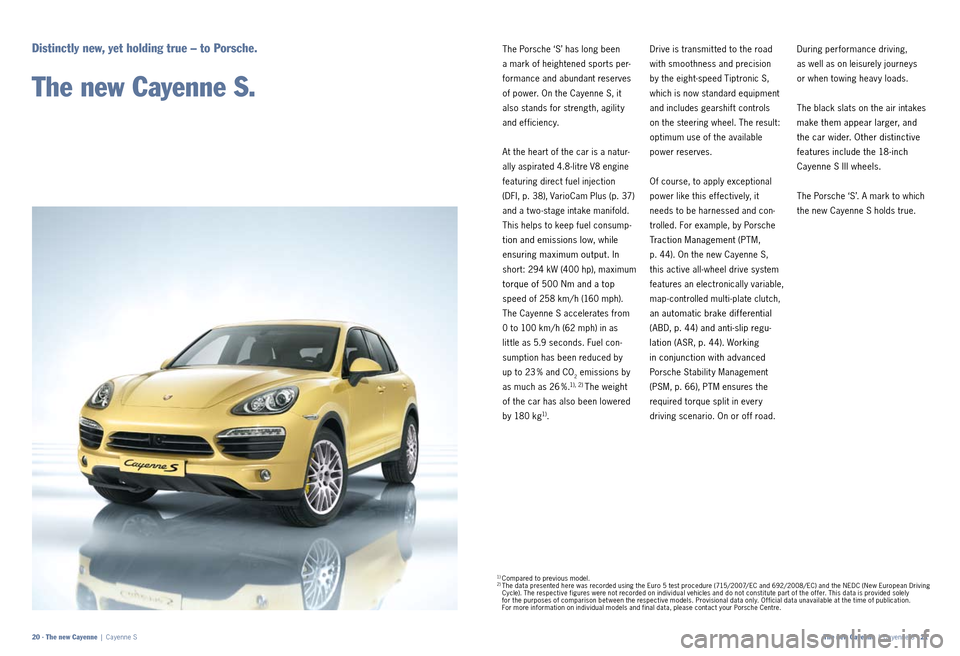
The Porsche ‘S’ has long been
a mark of heightened sports per
formance and abundant reserves
of power. On the Cayenne S, it
also stands for strength, agilit y
and efficiency.
At the heart of the car is a natur
ally aspirated 4.8 litre V8 engine
featuring direct fuel injection
(DFI, p. 38), VarioCam Plus (p. 37)
and a t wo stage intake manifold.
This helps to keep fuel consump
tion and emissions low, while
ensuring maximum output. In
short: 294 kW (400 hp), maximum
torque of 500 Nm and a top
speed of 258 km/ h (160 mph).
The Cayenne S accelerates from
0 to 100 km/ h (62 mph) in as
lit tle as 5.9 seconds. Fuel con
sumption has been reduced by
up to 23 % and CO
2 emissions by
as much as 26 %.
1), 2) The weight
of the car has also been lowered
by 180 kg
1). Drive is transmit ted to the road
with smoothness and precision
by the eight
speed Tiptronic S,
which is now standard equipment
and includes gearshif t controls
on the steering wheel. The result:
optimum use of the available
power reserves.
Of course, to apply exceptional
power like this ef fectively, it
needs to be harnessed and con
trolled. For example, by Porsche
Traction Management (PTM,
p. 44). On the new Cayenne S,
this active all wheel drive system
features an electronically variable,
map controlled multi plate clutch,
an automatic brake differential
(ABD, p. 44) and anti slip regu
lation (ASR, p. 44). Working
in conjunction with advanced
Porsche Stabilit y Management
(PSM, p. 66), PTM ensures the
required torque split in every
driving scenario. On or of f road. During performance driving,
as well as on leisurely journeys
or when towing heav y loads.
The black slats on the air intakes
make them appear larger, and
the car wider. Other distinctive
features include the 18 inch
Cayenne S III wheels.
The Porsche ‘S’. A mark to which
the new Cayenne S holds true.
Distinctly new, yet holding true – to Porsche.
The new Cayenne S.
1) Compared to previous model.2) The data presented here was recorded using the Euro 5 test procedure (715/2007/ EC and 692/2008/ EC) and the NEDC (New European Driving
Cycle). The respective figures were not recorded on individual vehicles and do not constitute part of the of fer. This data is provided solely
for the purposes of comparison bet ween the respective models. Provisional data only. Of ficial data unavailable at the time of publication.
For more information on individual models and final data, please contact your Porsche Centre.
The new Cayenne | Cayenne S · 21
20 · The new Cayenne | Cayenne S
Page 10 of 68

Understatement coupled with
clear statements: lower fuel
consumption, faster acceleration.
Supreme engineering that speaks
for itself. In short, every thing
you’d expect from a Turbo.
Another clear statement is the
distinctive sound from the t win
dualtube tailpipes. Produced by
the 4.8 litre t win turbo V8 engine
that delivers 368 kW (500 hp)
and features direct fuel injection
(DFI, p. 38). The car has a top
speed of 278 km/ h (173 mph)
and the benchmark sprint from
0 to 100 km/ h (62 mph) is com
pleted in 4.7 seconds. Maximum
torque is 700 Nm. Here too, fuel
consumption has been reduced
by
23 % and CO2 emissions by
2 5 % .
1), 2) Not least thanks to a
weight saving of 185 kg
1).
Optimum traction and safet y are
provided by Porsche Traction
Management (PTM, p. 44) active
all wheel drive. Also connecting
the car to the road are the new
19 inch Cayenne Turbo wheels. The chassis on the new Cayenne
Turbo is equipped as standard
with air suspension
featuring self
levelling and ride height control,
as well as Porsche Active Suspen
sion Management
(PASM, p. 51).
This electronic damping control
system offers continuous adjust
ment of the damping forces
on each wheel – depending on
current road conditions and
driving st yle.
This enables greater
car control, improving safet y and
comfort.
Comfort is also key in the new
Cayenne Turbo interior. Standard
equipment comprises an interior
package in smooth finish leather,
a rooflining in Alcantara and an
electrically adjustable steering
column.
Also fit ted as standard: the
BOSE® Surround Sound System,
Porsche Communication
Management (PCM) with navi
gation module, adaptive sports
seats with comfort memor y
package (18 way), Tyre Pressure Monitoring (TPM, p. 57), auto
matic headlight activation and
automatically dimming exterior
and interior mirrors.
Exterior features exclusive to
the new Cayenne Turbo include
Bi
Xenon headlights with Porsche
Dynamic Light System (PDLS,
p. 61), larger air intakes and a
distinctive ‘power dome’ on the
engine lid – a clear reference to
the enormous potential within.
Based on the same solid
foun
dations as its predecessor,
the new Cayenne Turbo blends
phenomenal performance with
comfort and ef ficiency. It does
so in st yle but without ever
compromising on any one in
particular. Because we believe
that less can also mean more.
Reduced weight, lower fuel consumption, fewer emissions.
At Porsche, we believe less is more.
The new Cayenne Turbo.
1) Compared to previous model.2) The data presented here was recorded using the Euro 5 test procedure (715/2007/ EC and 692/2008/ EC) and the NEDC (New European Driving
Cycle). The respective figures were not recorded on individual vehicles and do not constitute part of the of fer. This data is provided solely
for the purposes of comparison bet ween the respective models. Provisional data only. Of ficial data unavailable at the time of publication.
For more information on individual models and final data, please contact your Porsche Centre.
The new Cayenne | Cayenne Turbo · 25
24 · The new Cayenne | Cayenne Turbo
Page 17 of 68
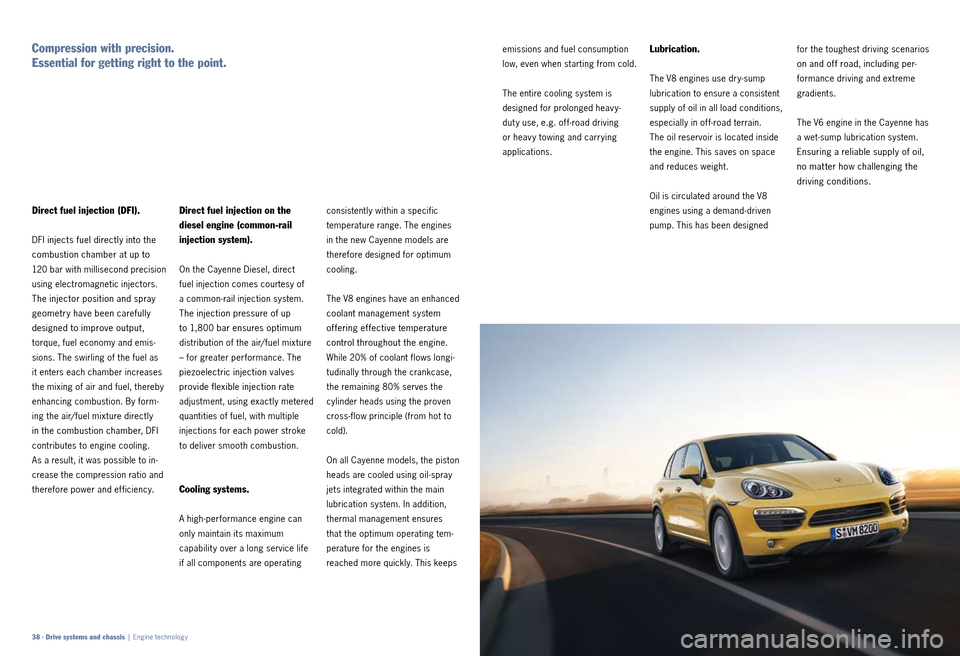
consistently within a specific
temperature range. The engines
in the new Cayenne models are
therefore designed for optimum
cooling.
The V8 engines have an enhanced
coolant management system
offering effective temperature
control throughout the engine.
While 20% of coolant flows longi
tudinally through the crankcase,
the remaining 80% serves the
cylinder heads using the proven
cross flow principle (from hot to
cold).
On all Cayenne models, the piston
heads are cooled using oil spray
jets integrated within the main
lubrication system. In addition,
thermal management ensures
that the optimum operating tem
perature for the engines is
reached more quickly. This keeps emissions and fuel consumption
low, even when starting from cold.
The entire cooling system is
designed for prolonged heav y
dut y use, e.g. of f road driving
or heav y towing and carrying
applications.
Lubrication.
The V8 engines use dry sump
lubrication to ensure a consistent
supply of oil in all load conditions,
especially in of f road terrain.
The oil reservoir is located inside
the engine. This saves on space
and reduces weight.
Oil is circulated around the V8
engines using a demand driven
pump. This has been designed for the toughest driving scenarios
on and off road, including per
formance driving and extreme
gradients.
The V6 engine in the Cayenne has
a wet sump lubrication system.
Ensuring a reliable supply of oil,
no mat ter how challenging the
driving conditions.
Direct fuel injection on the
diesel engine (common-rail
injection system).
On the Cayenne Diesel, direct
fuel injection comes courtesy of
a common rail injection system.
The injection pressure of up
to 1,800 bar ensures optimum
distribution of the air/fuel mixture
– for greater performance. The
piezoelectric injection valves
provide flexible injection rate
adjustment, using exactly metered
quantities of fuel, with multiple
injections for each power stroke
to deliver smooth combustion.
Cooling systems.
A high performance engine can
only maintain its maximum
capabilit y over a long service life
if all components are operating
Direct fuel injection (DFI).
DFI injects fuel directly into the
combustion chamber at up to
120 bar with millisecond precision
using electromagnetic injectors.
The injector position and spray
geometry have been carefully
designed to improve output,
torque, fuel economy and emis
sions. The swirling of the fuel as
it enters each chamber increases
the mixing of air and fuel, thereby
enhancing combustion. By form
ing the air/fuel mixture directly
in the combustion chamber, DFI
contributes to engine cooling.
As a result, it was possible to in
crease the compression ratio and
therefore power and efficiency.
Compression with precision.
Essential for getting right to the point.
38 · Drive systems and chassis | Engine technology
Page 18 of 68
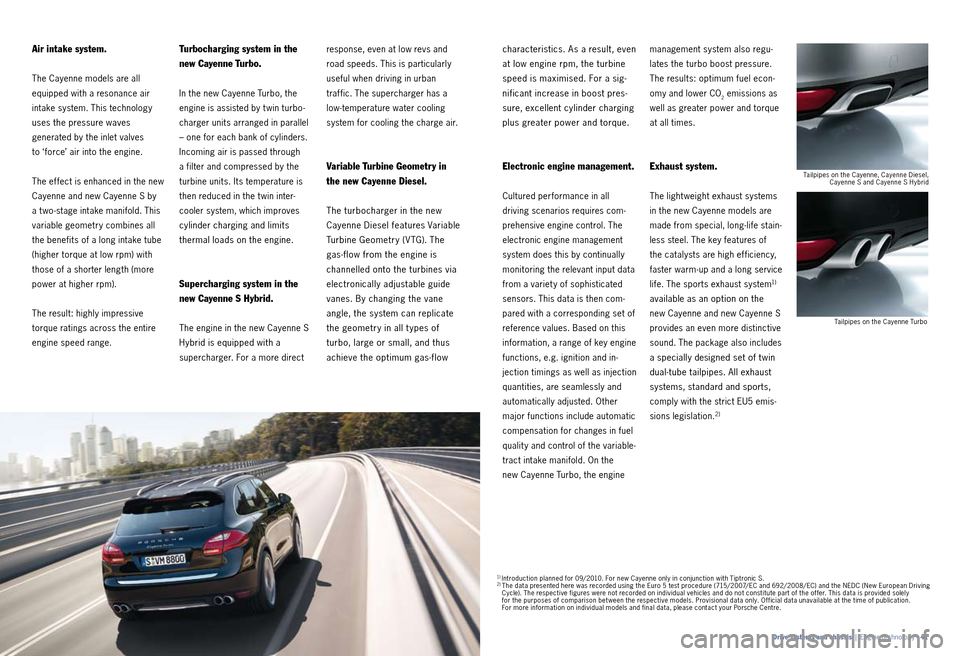
response, even at low revs and
road speeds. This is particularly
useful when driving in urban
traf fic. The supercharger has a
lowtemperature water cooling
system for cooling the charge air.
Variable Turbine Geometry in
the new Cayenne Diesel.
The turbocharger in the new
Cayenne Diesel features Variable
Turbine Geometry (V TG). The
gas flow from the engine is
channelled onto the turbines via
electronically adjustable guide
vanes. By changing the vane
angle, the system can replicate
the geometry in all t ypes of
turbo, large or small, and thus
achieve the optimum gas flow characteristics. As a result, even
at low engine rpm, the turbine
speed is maximised. For a sig
nificant increase in boost pres
sure, excellent cylinder charging
plus greater power and torque.
Electronic engine management.
Cultured performance in all
driving scenarios requires com
prehensive engine control. The
electronic engine management
system does this by continually
monitoring the relevant input data
from a variet y of sophisticated
sensors. This data is then com
pared with a corresponding set of
reference values. Based on this
information, a range of key engine
functions, e.g. ignition and in
jection timings as well as injection
quantities, are seamlessly and
automatically adjusted. Other
major functions include automatic
compensation for changes in fuel
qualit y and control of the variable
tract intake manifold. On the
new Cayenne Turbo, the engine management system also regu
lates the turbo boost pressure.
The results:
optimum fuel eco
n
omy and lower CO
2 emissions as
well as greater power and torque
at all times.
Exhaust system.
The light weight exhaust systems
in the new Cayenne models are
made from special, long life stain
less steel. The key features of
the catalysts are high ef ficiency,
faster warm up and a long service
life. The sports exhaust system
1)
available as an option on the
new Cayenne and new Cayenne S
provides an even more distinctive
sound. The package also includes
a specially designed set of t win
dual tube tailpipes. All exhaust
systems, standard and sports,
comply with the strict EU5 emis
sions legislation.
2)
Turbocharging system in the
new Cayenne Turbo.
In the new Cayenne Turbo, the
engine is assisted by t win turbo
charger units arranged in parallel
– one for each bank of cylinders.
Incoming air is passed through
a filter and compressed by the
turbine units. Its temperature is
then reduced in the t win inter
cooler system, which improves
cylinder charging and limits
thermal loads on the engine.
Supercharging system in the
new Cayenne S Hybrid.
The engine in the new Cayenne S
Hybrid is equipped with a
supercharger. For a more direct
Air intake system.
The Cayenne models are all
equipped with a resonance air
intake system. This technology
uses the pressure waves
generated by the inlet valves
to ‘force’ air into the engine.
The ef fect is enhanced in the new
Cayenne and new Cayenne S by
a t wo stage intake manifold. This
variable geometry combines all
the benefits of a long intake tube
(higher torque at low rpm) with
those of a shorter length (more
power at higher rpm).
The result: highly impressive
torque ratings across the entire
engine speed range.
1 ) Introduction planned for 09/2010. For new Cayenne only in conjunction with Tiptronic S.2) The data presented here was recorded using the Euro 5 test procedure (715/2007/ EC and 692/2008/ EC) and the NEDC (New European Driving
Cycle). The respective figures were not recorded on individual vehicles and do not constitute part of the of fer. This data is provided solely
for the purposes of comparison bet ween the respective models. Provisional data only. Of ficial data unavailable at the time of publication.
For more information on individual models and final data, please contact your Porsche Centre. Tailpipes on the Cayenne, Cayenne Diesel,
Cayenne S and Cayenne S Hybrid
Tailpipes on the Cayenne Turbo
Drive systems and chassis | Engine technology · 41
Page 25 of 68
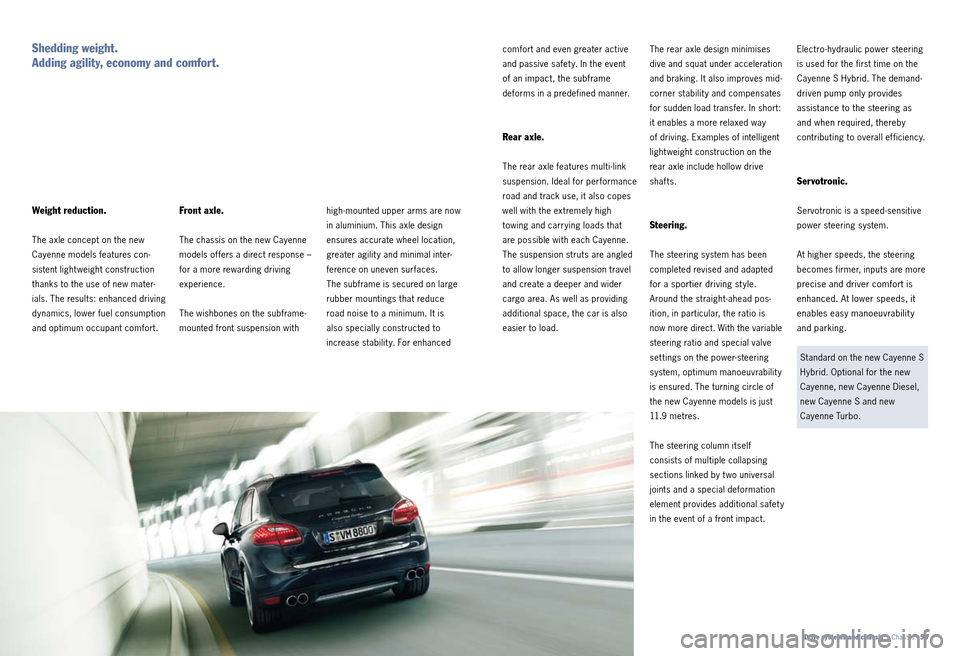
highmounted upper arms are now
in aluminium. This axle design
ensures accurate wheel location,
greater agilit y and minimal inter
ference on uneven surfaces.
The subframe is secured on large
rubber mountings that reduce
road noise to a minimum. It is
also specially constructed to
increase stabilit y. For enhanced comfort and even greater active
and passive safet y. In the event
of an impact, the subframe
deforms in a predefined manner.
Rear axle.
The rear axle features multi
link
suspension. Ideal for performance
road and track use, it also copes
well with the extremely high
towing and carrying loads that
are possible with each Cayenne.
The suspension struts are angled
to allow longer suspension travel
and create a deeper and wider
cargo area. As well as providing
additional space, the car is also
easier to load. The rear axle design minimises
dive and squat under acceleration
and braking. It also improves mid
corner stabilit y and compensates
for sudden load transfer. In short:
it enables a more relaxed way
of driving. Examples of intelligent
light weight construction on the
rear axle include hollow drive
shafts.
Steering.
The steering system has been
completed revised and adapted
for a sportier driving st yle.
Around the straight ahead pos
ition, in particular, the ratio is
now more direct. With the variable
steering ratio and special valve
set tings on the power steering
system, optimum manoeuvrabilit y
is ensured. The turning circle of
the new Cayenne models is just
11.9 metres.
The steering column itself
consists of multiple collapsing
sections linked by t wo universal
joints and a special deformation
element provides additional safet y
in the event of a front impact. Electro
hydraulic power steering
is used for the first time on the
Cayenne S Hybrid. The demand
driven pump only provides
assistance to the steering as
and when required, thereby
contributing to overall efficiency.
Servotronic.
Servotronic is a speed sensitive
power steering system.
At higher speeds, the steering
becomes firmer, inputs are more
precise and driver comfort is
enhanced. At lower speeds, it
enables easy manoeuvrability
and parking.
Standard on the new Cayenne S
Hybrid. Optional for the new
Cayenne, new Cayenne Diesel,
new Cayenne S and new
Cayenne Turbo.
Front axle.
The chassis on the new Cayenne
models of fers a direct response –
for a more rewarding driving
experience.
The wishbones on the subf rame
mounted front suspension with
Weight reduction.
The axle concept on the new
Cayenne models features con
sistent light weight construction
thanks to the use of new mater
ials. The results: enhanced driving
dynamics, lower fuel consumption
and optimum occupant comfort.
Shedding weight.
Adding agility, economy and comfort.
Drive systems and chassis | Chassis · 55
Page 26 of 68

Ty r e s .
All t yres have been optimised
with regard to driving perform
ance, handling, rolling resistance
and weight. They also provide
great potential for reducing fuel
consumption and emissions. The three basic components of
the t yre have been enhanced –
the rubber compound, tread de
sign and the architecture of the
substructure. This reduces rolling
resistance and fuel consumption.
Tyre Pressure Monitoring
(TPM).
Tyre Pressure Monitoring (TPM)
provides early warning of any
drop in pressure via the on
board
computer display. In addition, the driver can quickly
and easily check the individual
pressures in all four wheels via
the multi
purpose display in the
instrument cluster. Standard on the new Cayenne
Turbo. Optional for all other
new Cayenne models.
Wheels.
All of the wheels for the new
Cayenne models have been
specifically designed to reflect
the character of the car – and
convey it to the road.
Standard on the new Cayenne
and new Cayenne Diesel: the
new 18 inch Cayenne wheel.
Standard on the new Cayenne S
and new Cayenne S Hybrid:
the new 18 inch Cayenne S III
wheel. Standard on the new
Cayenne Turbo: the new 19 inch
Cayenne Turbo wheel.
1)
A range of other wheel options
in various sizes (up to 21 inches
in diameter) is available for all
models.
19 inch Cayenne Turbo wheel
20 inch RS Spyder Design wheel
18 inch Cayenne S III wheel 20
inch Cayenne SportDesign II wheel
18 inch Cayenne wheel 19
inch Cayenne Design II wheel2)
More than just a small cog in the system.
21 inch Cayenne SportEdition wheel3)21 inch 911 Turbo II wheel (forged)
1) For details of all wheel options, see page 118. 2) In conjunction with 275 mm t yres for the
Cayenne Turbo and 265 mm t yres for all
other models.
3) Introduction planned for 07/2010.
Drive systems and chassis | Chassis · 57
56 · Drive systems and chassis | Chassis
Page 30 of 68
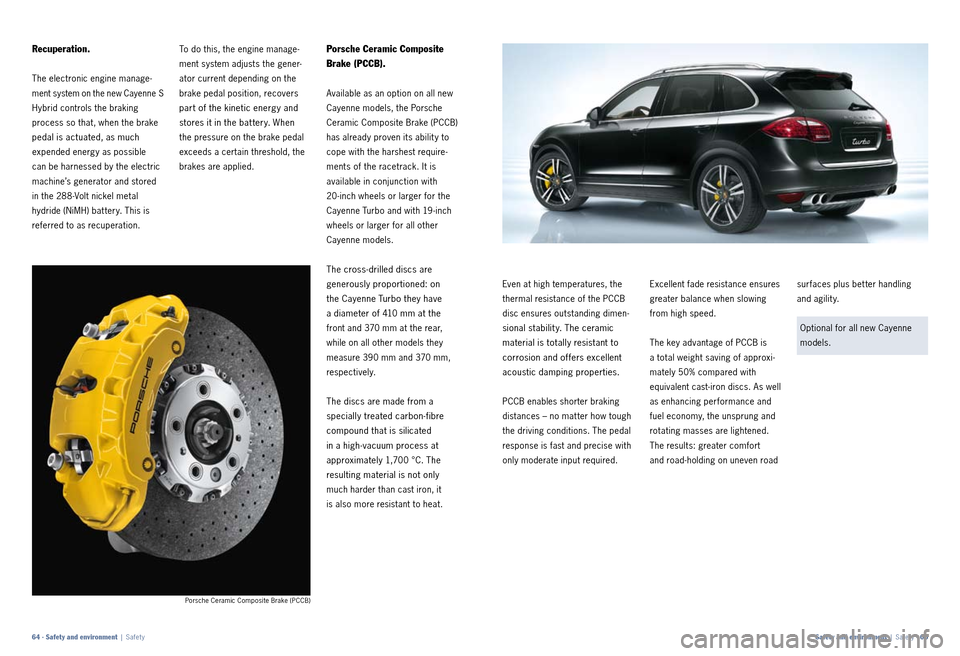
Porsche Ceramic Composite Brake (PCCB)
To do this, the engine manage
ment system adjusts the gener
ator current depending on the
brake pedal position, recovers
part of the kinetic energy and
stores it in the bat tery. When
the pressure on the brake pedal
exceeds a certain threshold, the
brakes are applied.
Porsche Ceramic Composite
Brake (PCCB).
Available as an option on all new
Cayenne models, the Porsche
Ceramic Composite Brake (PCCB)
has already proven its abilit y to
cope with the harshest require
ments of the racetrack. It is
available in conjunction with
20 inch wheels or larger for the
Cayenne Turbo and with 19 inch
wheels or larger for all other
Cayenne models.
The cross drilled discs are
generously proportioned: on
the Cayenne Turbo they have
a diameter of 410 mm at the
front and 370 mm at the rear,
while on all other models they
measure 390 mm and 370 mm,
respectively.
The discs are made from a
specially treated carbon fibre
compound that is silicated
in a high vacuum process at
approximately 1,700 °C. The
resulting material is not only
much harder than cast iron, it
is also more resistant to heat. Even at high temperatures, the
thermal resistance of the PCCB
disc ensures outstanding dimen
sional stabilit y. The ceramic
material is totally resistant to
corrosion and offers excellent
acoustic damping properties.
PCCB enables shorter braking
distances – no mat ter how tough
the driving conditions. The pedal
response is fast and precise with
only moderate input required. Excellent fade resistance ensures
greater balance when slowing
from high speed.
The key advantage of PCCB is
a total weight saving of approxi
mately 50% compared with
equivalent cast iron discs. As well
as enhancing performance and
fuel economy, the unsprung and
rotating masses are lightened.
The results: greater comfort
and road holding on uneven road surfaces plus bet ter handling
and agility.
Optional for all new Cayenne
models.
Recuperation.
The electronic engine manage
ment system on the new Cayenne S
Hybrid controls the braking
process so that, when the brake
pedal is actuated, as much
expended energy as possible
can be harnessed by the electric
machine’s generator and stored
in the 288 Volt nickel metal
hydride (NiMH) bat tery. This is
referred to as recuperation.
Safety and environment | Safet y · 65
64 · Safety and environment | Safet y
Page 32 of 68

curtaint ype airbags on each
side of the roof offering opti
mum head protection for both
rows of seats and side impact
protection elements in each
door. Side airbags at the rear
are also available as an option.
Two impact sensors are located
at the front of the car to enable
bet ter detection of a headon
collision. The driver and front
passenger airbags use a gas
generant based on an organic
propellant. As a result, the air
bags are lighter, more compact
and easier to recycle. A roll over
detection system provides
additional protection in the event
that the car were to overturn.
Using sensor acquired data, it
enables early deployment of
the curtain airbags and triggers
the seat belt pre tensioners.
Seat belt system.
The Cayenne models feature
three point seat belts on all
five seats, as well as seat belt
pre tensioners (front and outer
rear seats) and force limiters
(front seats only).
ISOFIX mounting points.
The front passenger seat and
outer rear seats are equipped
with ISOFIX mounting points for
compatible child seats (p. 84)
as standard. If a child seat is
mounted on the front passenger
seat, the corresponding airbag
can be quickly deactivated using
a key operated switch.
Airbags.
All Cayenne models are equipped
with full size front airbags for
driver and front passenger as
standard. These are augmented
by Porsche Side Impact Protec
tion (POSIP). This comprises
a side airbag in each front seat,
Bodyshell construction.
Our ongoing development of
the light weight steel body is a
decisive factor in the enhanced
passive safet y and unparalleled
rigidit y of the Cayenne body.
In the event of an accident, a
system of side and cross
members at the front of the car
helps to channel impact energy
in a safe and predetermined
manner. The interior is protected
by hot formed super high strength
steel reinforcements, including
side intrusion beams in each of
the doors.
High strength and consistent
deformation properties: t wo
key safet y requirements fulfilled
by the multiphase steel used
throughout the body. Thanks to
a safet y cage structure made
from high tech steels, the highly
resilient passenger cell of fers
high levels of protection.
Placing great weight on safety.
While taking things lightly.
Passive safet y: airbags
Safety and environment | Safet y · 69
68 · Safety and environment | Safet y Passive safet y: bodyshell
Multi
phase steels
Boron alloyed steels
Plastic Aluminium
Deep
drawn steels
High strength micro alloyed steels
Page 33 of 68
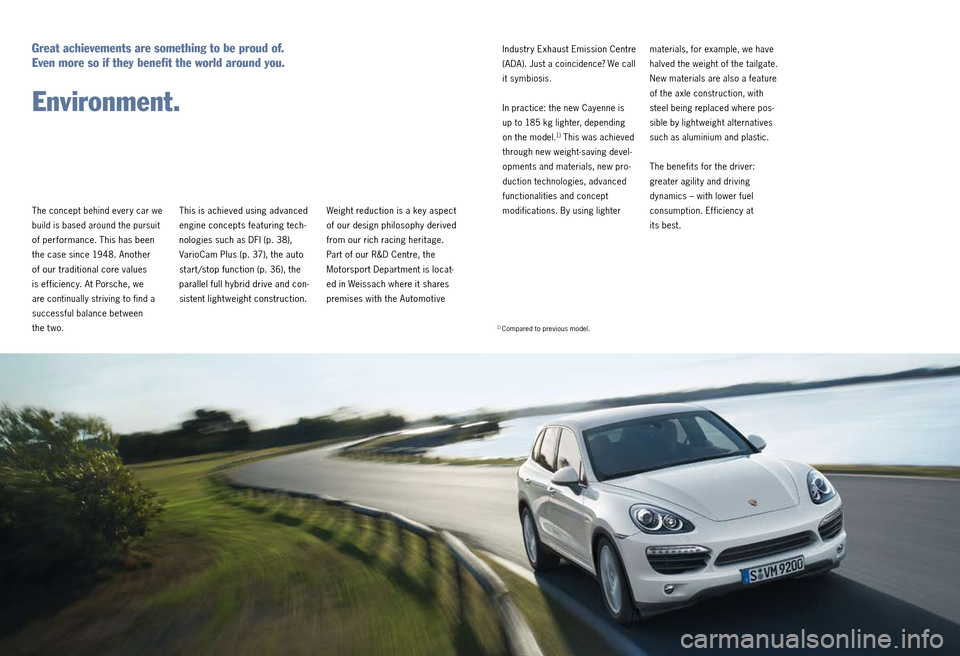
Weight reduction is a key aspect
of our design philosophy derived
from our rich racing heritage.
Part of our R&D Centre, the
Motorsport Department is locat
ed in Weissach where it shares
premises with the Automotive Industry Exhaust Emission Centre
(ADA).
Just a coincidence? We call
it symbiosis.
In practice: the new Cayenne is
up to 185 kg lighter, depending
on the model.
1) This was achieved
through new weight saving devel
opments and materials, new pro
duction technologies, advanced
functionalities and concept
modifications. By using lighter materials, for example, we have
halved the weight of the tailgate.
New materials are also a feature
of the axle construction, with
steel being replaced where pos
sible by light weight alter
natives
such as aluminium and plastic.
The benefits for the driver:
greater agilit y and driving
dynamics – with lower fuel
consumption. Ef ficiency at
its best.
This is achieved using advanced
engine concepts featuring tech
nologies such as DFI (p. 38),
VarioCam Plus (p. 37), the auto
start /stop function (p. 36), the
parallel full hybrid drive and con
sistent light weight construction.The concept behind every car we
build is based around the pursuit
of performance. This has been
the case since 1948. Another
of our traditional core values
is efficiency. At Porsche, we
are continually striving to find a
successful balance bet ween
the t wo.
Great achievements are something to be proud of.
Even more so if they benefit the world around you.
Environment.
1) Compared to previous model.